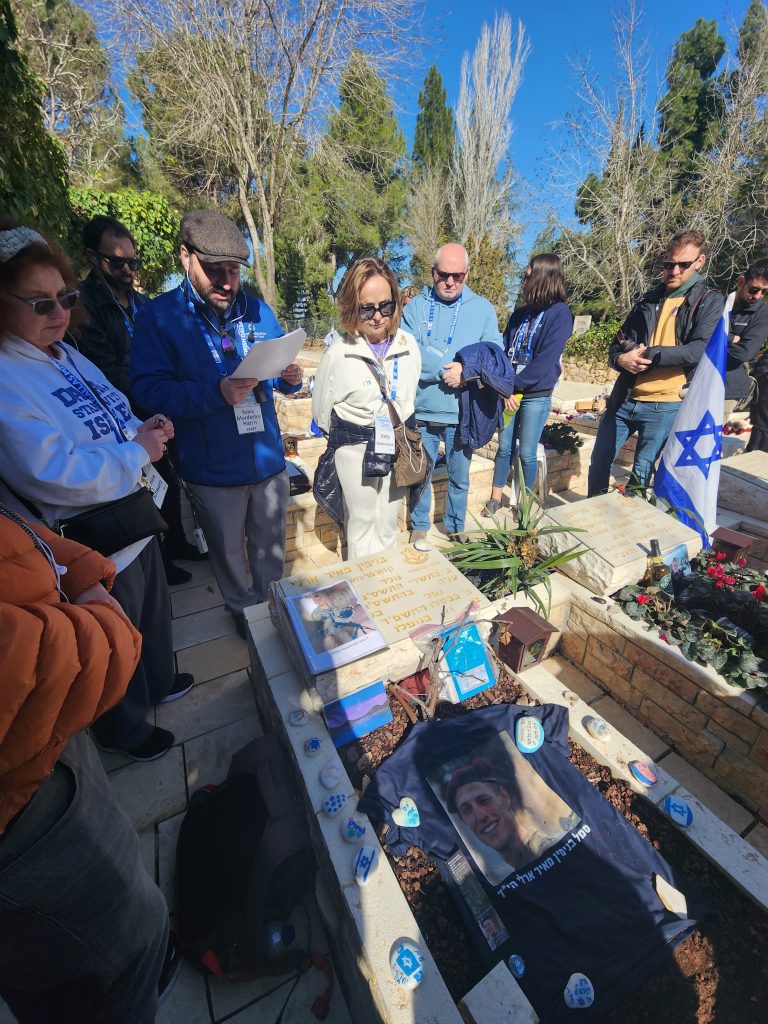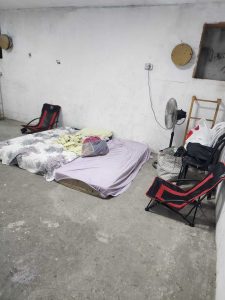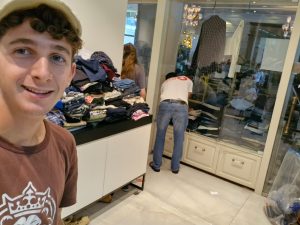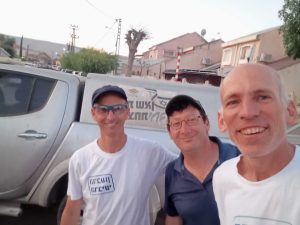2024 ה’תשפ”ד
Yom HaZikaron Lashoah VeLaGvurah (Holocaust and Heroism Remembrance Day), Yom HaZikaron LeHalelei Ma’arkhot Yisrael ul’Nifgeei Pe’ulot HaEivah (Memorial Day for the Fallen Soldiers of the Wars of Israel and the Victims of Terrorism), and Yom Ha’atzmaut (Israel’s Independence Day).
As I approach these ten days, my heart weighs heavy. I’ve spent many years guiding and educating fellow Jews through this time, bridging the diverse Israeli experiences with the broader narrative of the Jewish people. Overwhelmed by emotions and thoughts, I hope this period will personally impact me, guiding me to contribute meaningfully to the ongoing existence and prosperity of my people – the Jewish people – and my homeland, the Jewish and Democratic State of Israel.
Countless times, I have stood with groups around the graves of fallen soldiers in the Military Cemetery on Mount Herzl in Jerusalem and posed the question, “The Price of our State – is it worth it?” My answer has always been, “If the Shoah” — pointing to Yad Vashem at the bottom of the very mountain we are on — “never happens again, and if the dream,” referring to Herzl as an example, buried on the summit of the very same mountain, “of an independent Jewish Democratic State in the Land of Israel, continues to exist.”
And then came the 7th of October. Israel was awakened to an unprecedented number of sirens warning of a missile attack from the Gaza Strip. This was followed by horrific scenes of pickup trucks loaded with terrorists storming the Jewish communities and cities adjacent to the Gaza Strip, and the cries of helpless citizens for urgent help. By the end of the day, and in the days that followed, the magnitude of the catastrophe became clear – we experienced a Churban, a destruction different yet comparable to the destructions of the First and Second Temples in Jerusalem, the Spanish Inquisition, other persecutions and pogroms against Jews throughout history, and the Shoah.
Mount Herzl, also known as Har Herzikaron – Mount of Memory and Memorial, is one of two mountains in Jerusalem we recognize as holy spaces, representing the national identity of the Jewish People (the other being Mount Moriah – Temple Mount, representing the religious culture of the Jewish People, a site that marks the covenant between the creator of the world and the Jewish People). The State of Israel has a special national calendar, including a holy week, between Yom HaZikaron Lashoah VeLaGvurah (Holocaust and Heroism Remembrance Day), Yom HaZikaron LeHalelei Ma’arkhot Yisrael ul’Nifgeei Pe’ulot HaEivah (Memorial Day for the Fallen Soldiers of the Wars of Israel and the Victims of Terrorism), and Yom Ha’atzmaut (Israel’s Independence Day). This week is represented in the structure of Mount Herzl.
At the bottom of the mountain, the lowest place represents the low of the Jewish People during the Shoah. Here sits Yad Vashem, Israel’s official memorial for the victims of the Holocaust, which also hosts the official national memorial opening for Yom HaShoah. On the summit lies the burial place of Theodor Herzl, representing the dreamer of a Jewish independent state in the land of Israel, and the Plaza that hosts the annual official national transformation ceremony from Yom Hazikaron to Yom Ha’atzmaut. And in the middle, between the depth and the summit, lies the largest military cemetery in Israel, which hosts the official national memorial service at 11 a.m. on Yom HaZikaron. (Memorial ceremonies take place at the same time at all military cemeteries across Israel, in schools, municipalities, workplaces, etc.)
This period in Israel has been imbued with significance over the seven and a half decades since the Independence of the State of Israel. Master Jewish educator and personal mentor, Avraham Infeld, offered the conceptualization of Nine Days of We’.[1] Infeld emphasizes the important idea that these nine days are not just Israeli days, but they carry the memory of events that influenced and changed the Jewish people as a whole. They are days that deepen our understanding and values of who WE are as the Jewish people. The Mabua – Israeli Beit Midrash has offered the concept of Aseret Yemay Todah, Ten Days of Gratitude, for the past seven years.[2] They offer a fresh perspective for this generation, reminding them not to take the existence of the State of Israel for granted, and to practice gratitude for what we have and the price we paid and continue to pay for it. To date, they have offered and practiced a wide range of methods of gratitude, aiming to train our gratitude muscles, including the practice of reading Israel’s Declaration of Independence to the traditional liturgical melody during Yom Ha’atzmaut.
This year, we confront two very challenging questions regarding these Ten Days on our national calendar. The first concerns our emotional state and our ability to celebrate these days while we are a state in trauma. The second concerns the meaning of these days to the State of Israel and its citizens, as well as to the Jewish world as a whole.
To answer the first question, I would like to draw on two teachings offered by Rabbi Dani Segel, head of Mabua – Israeli Beit Midrash, during a Zoom session for educators in preparation for the upcoming National Holidays – the Ten Days of Gratitude.
The first teaching Rabbi Segel draws on is a conversation he heard between Rabbi Itamar Eldar and Rabbi Yaaqov Medan days after his son Elisha Medan was critically injured while fighting in Gaza. They discussed a teaching by Rabbi Nachman of Breslov regarding the statement “Mitzvah Gedola L’hiyot B’Shimcha” – “it is a great mitzvah to always be happy”.
And joy is a great healer! In the Future, joy will increase tremendously. For this reason our Sages, of blessed memory, said: “The Blessed Holy One will head the choleh (circle) of the tzaddikim in the time to come” (Yerushalmi, Megillah 2:4). That is, He will form a machol (circle dance) for the tzaddikim, and He, the Blessed One, will be at the circle’s head. For the Divine Presence hovers above the head of the choleh (one who is ill), as our Sages, of blessed memory, expounded (Nedarim 40a) : As it is stated, “God sustains him [from] upon the sickbed” (Psalms 41:4). For the sick person has no vitality at all; it is only the Divine Presence that gives him life. Thus, in the Future, all sickness will be remedied through joy. And then God will head the ChoLeh (circle)—i.e., be head of the maChoL (circle dance)—because joy is the remedy for the ChoLeh (one who is ill). This is the reason that joy and dance are called ChoLeh, because they are the remedy for ChoLaat (illness).[3]
Rabbi Nachman draws on the similarity between the word “Chole” – one who is sick, and the word “Machol” – to dance in a circle. Dancing brings joy, and joy brings healing to the sick. The beloved in Song of Songs says “חולת אהבה אני” – “I am faint/sick with love” (Song of Songs 5:8), which can be read in this way: “I am dancing around love.”
Dance has the ability to heal. It is a great mitzvah to experience joy and happiness. This is not referring to happiness as an outcome, something we all enjoy and need, but rather it is referring to joy and happiness during tough and challenging times. It is a tool we can use, a treatment tool we must use, during these extreme circumstances. The ability to come forward, to smile, and say positive things, to raise our heads up high – is not a privilege. It is saying we need this now, to heal.
For his second teaching, Rabbi Segel draws on the Mei Hashiloach, Rabbi Mordechai Yosef Leiner of Izbica (The Isbitzer), a great Hasidic thinker and teacher of the first half of the 19th century.
“… say to the Cohanim … do not make yourselves impure from the dead of your people.” (Vayikra, 21:1) The Cohen is chosen as the vehicle through which all the actions of Israel will be rectified and acceptable before the Holy One, blessed be He. Therefore He warned them about impurity from the dead, for death brings about the opposite. There are three levels of soul found in man: (in ascending order) nefesh, ruach, and neshama. The vitality of the nefesh is only complete when it is connected to the higher levels of ruach and neshama. Therefore at night when the ruach and the neshama separate from the body, only the nefesh remains and has no ability to effect conscious physical action. This is why we say every morning, “Blessed are You, who straightens the bent,” for when the ruach and the neshama are reconnected to the nefesh and the body who were, so to speak, “bent over,” are straightened and upright. As we find in man, so too do we find in the whole community of Israel. The Cohen is the head of the body of Israel. Just as there is the aspect of thought in in man’s soul, and the body is under the influence of his thoughts, so too the rest of Israel are all on different levels, one higher than the other. It is like the organs and limbs of man, starting with the head, and evolving out to the organs of action (fingers, feet, mouth). When man is awake the head controls the body, as in the famous saying of the Baal Shem Tov, “a man is where his thoughts are.” When he is asleep, there is no difference between the head and the rest of the body. Therefore God warned the Cohanim not to become impure from the dead, since the Cohen is in charge of the body of Israel and has the power to rectify all of their actions. Death teaches of the opposite of this, for in death he has no power of action to fix all that he has perverted in his life. The Cohen’s unique ability to rectify the actions of Israel is so that nothing would become irrecoverably lost in exile.[4]
The Mei HaShiloach contemplates the Jewish concept of Tumah and Tahara, purity and impurity. The source of tumah – impurity is death, and the highest level of impurity is exposure to tumat meit – a corpse. The Cohen, priest, is prohibited to expose himself to the dead, for which the Mei HaShiloach offers us a deep concept. Human beings are created in order to do, to create, to fix. A state of possibilities of possibilities. Death – is the end to that state, and impurity takes you out of the game for a period, no possibilities for possibilities, until you are pure again, and back in the game. Leaders, educators of a community are responsible for the possibilities for possibilities, for doing, for fixing and creating. A community can’t go without. And therefore, according to the Mei HaShiloach, the Cohanim, are set aside, by not exposing themselves to impurity. A community must set aside a percentage of leaders – that stay optimistic. To smile, to be in joy is not a privilege, rather a requirement. It is a duty.
Rabbi Segel teaches us that those who can smile in our circumstances, those who can celebrate and retain a state of joy – must. It is a duty of holding up the spirit. And those who can’t will turn to others around them, and ask them to maintain the spirit of our nation.
The ability to be joyful during war, and the dilemma around the way we mark and celebrate special events, life cycle events, and holidays, both individually and collectively, is ongoing. We saw it around Hanukkah, Purim, and Passover, birthdays, brit milahs, weddings, and now the upcoming National days.
One place I draw from is the Shalom Hartman Institute’s Center for Ritual: The staff, Rabbi Tamar Elad-Appelbaum, Dr. Rani Jaeger, Hagit Bartuv, Adva Hacohen Boumendil, and Dr. Rivka Rosner-Shiloni, have been uploading and offering thoughts and liturgical ideas to help us through these complicated emotional events.
One piece is ‘An invitation to joy in times of war’.[5] The invitation is to give gratitude for what we have while recognizing our personal and collective state of darkness.
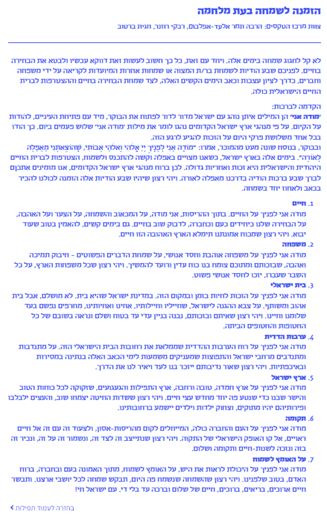
In her poem “At this moment,” contemporary Israeli poet Iris Eliya-Cohen urges us to gather joy much like a child collecting napkins. She prompts us to delicately lay them out on the table’s edge, our hands trembling with excitement, and to examine them with hopeful eyes.
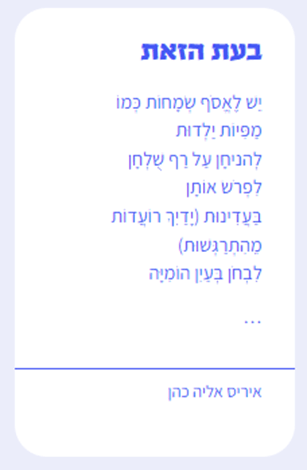
I am grateful to Rabbi Dani Segel for these teachings, and many others that are uplifting our spirits. The question of how we will approach this year’s national holidays concerns me, and I’m sure everyone else. As we all struggle to find the mindset that suits us, I draw strength from him, his teachings, and many others. And I hope you do too.
To try to find ways to contemplate and understand the meaning of these days for the Jewish people this year, we must start by understanding their significance since May 14, 1948, up to October 6, 2023.
Yom HaShoah – the Israeli national day commemorating the Jewish story at large, not just the Israeli story. The Shoah occurred outside the borders of Israel, to members of the Jewish people living elsewhere. A third of the Jewish people were annihilated. The Shoah profoundly changed the Jewish people.
Yom Ha’atzmaut, an Israeli celebration, commemorates the Jewish story at large of the creation of the Jewish State. The Jewish people gained sovereignty and power.
Yom HaZikaron, an Israeli memorial for those who gave their lives so the Jewish people could once again obtain sovereignty and power. Yom Ha’atzmaut celebrates that the price we paid, the sacrifice, for our state was worth it, and that what happened during the Shoah to the Jewish people will never happen again, to no Jew regardless of where they reside. It changed the status of every Jew in the world, as the creation of the state eliminated the term ‘Jewish Refugee’.[7]
Israeli contemporary intellectual and poet Tzur Ehrlich captured this sentiment in his short poem published in 2013.
A WEEK APART
Two adjacent memorial days every year,
For the benefit of the general calculation,
The price of a state of our own
and the price of going without.
Tzur Ehrlich, 14.4.2013
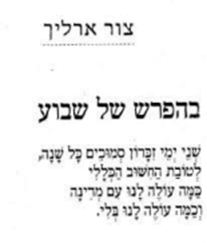
This is the story of the Jewish People as a whole, and the relationships between those living within the borders of the State of Israel and those living outside of it.
On October 7th, 2023, the Jewish people experienced a catastrophe that overturned the basic notion that we are home and not in the Galut – exile/diaspora, and that persecution and pogroms, as we knew them in our history, are over. Not only did they occur in the most horrific manner, but they happened in our Jewish sovereign state. Micha Goodman stresses that during October 7th, parts of Israel were in a state of Galut. The western Negev, also known as the Gaza envelope, for 24 hours was part of Gaza and not the state of Israel.[8] For over a day, Gaza encroached into Israel, and parts of Israel became Gaza. The state of Galut was not only geographic but also historical, as we reverted to a period of pogroms, and the state of Israel did not intervene. For twenty-four hours, the sovereign state of Israel, Jews with power, seemed to cease to exist. Galut appeared within our state.
On October 7th, we, the fourth generation of Israelis, were given a wake-up call that reminded us that the state of Israel is not a given factor, and that we should not take it for granted. We were given the perspective of the first generation, the generation who knew a state of Jewish Galut and knew a state of Jewish statehood.[9] In Bereishit 5:1, we learn that “Adam knew Chava, his wife.” The word for “knew” is “Yada,” and is understood as experiential knowledge, not just merely cognitive. Many Israelis were brought back to the starting point, to the beginning, to the deep experiential understanding of what it is to be without a state, and the need for a strong Jewish and Democratic State. And many have risen to the moment, in military service and outstanding civil service, that continues until today. Micha Goodman stresses that the fourth generation of the state of Israel not only perceives the reality now through the lens of the first generation but are a new first generation, with the responsibility to reestablish, maintain, and secure a stronger and better Jewish Democratic State in the state of Israel.
The price, the price we paid for this perspective on October 7th, and continue to pay to meet this challenge, is very heavy and unbearable on both a personal and national level. On October 7, and during the war in Gaza and on the northern border that followed, and is not over yet, 1,495 Israelis were murdered, out of them over 600 soldiers. 257 Israelis were taken hostage in the Gaza Strip on October 7, and only 124 have been returned to date. There are still 133 Israelis held hostage by Hamas and terrorist organizations in Gaza, out of them 16 have been declared dead. About 100,000 Israelis have been evacuated and displaced from their homes around Gaza and the northern border for over six months, without a sense of when they will be able to return home and the assurance that when they do, they will be safe. This is a heavy price to pay, for a first-generation perspective, for ensuring the continuing existence and prosperity of a Jewish and Democratic State in Israel.
The upcoming national holidays this year take us back to 1949 when Israel celebrated its first Independence Day. However, we don’t only have the perspective of the first generation; we also have the perspective of 150 years of Zionist dreamers and achievers who envisioned, created, and built a vibrant state for 75 years.
This year, we must ask ourselves: who do we need to be as members of the Jewish People and as citizens of the State of Israel to ensure the continued existence and prosperity of the Jewish and Democratic State of Israel now and in the future? What dreams do we need to dream, and what achievements do we need to accomplish? How can each of us, individually, and as the Jewish people as a whole, contribute to this endeavor?
What actions can we take during this period of our national holidays? I’m certain there are numerous possibilities. I’ll present a few ideas, some of which are my own and others from esteemed educators and organizations in Israel that are diligently working toward this goal.
However we opt to spend this period, it should encompass personal and individual aspects, as well as communal and collective ones, and it should involve multiple generations. It should be personal and individual because each of us is unique and must find our own connection to the Jewish people and the State of Israel. The Jewish people have always been diverse and inclusive, with a wide range of perspectives and practices. Therefore, each individual should delve deep into their minds, souls, and hearts to uncover the personal story that binds them. The tent is large.
Collective and communal because we are a family, a mishpocha, and it is only in a communal setting that we come together around our common narrative, our history, and our shared destiny. Within the community, individuals can find a platform to express and utilize their passions, strengths, and abilities for a greater purpose.
And multigenerational, because of our responsibility to pass it on to the next generation. We must share our story, values, and vision for the Jewish People and find a way to pass the baton forward. The commandment “וְהִגַּדְתָּ֣ לְבִנְךָ֔” (‘And you shall explain to your child’) (Exodus 13:8) is to bring a sense of connection and commitment to the next generation. The next generation of Jews must be able to find their passion and commitment to the continuing prosperity of the Jewish People and the State of Israel, and we must help them find a way to tie them into the Jewish story. I heard someone say we must make Gen Z, Gen Zionist. I know this is a challenge. The story is much broader, and just as one is connected to his or her family by genes and the family story, so we should work hard to pass on the importance of these days, and what they stand for, to our next generation. It was a sense of family that kept the Jews connected in a network of mutual guarantee, even when they were spread all over the world. And we must make sure this sense of family continues.
First and foremost, ensure that this period doesn’t pass by unnoticed. Dedicate time each day and throughout the period to its significance. Ensure that educators, schools, and rabbis emphasize this period and organize related programs. Bring its importance to the forefront of everyone’s attention. In Israel, it has become increasingly popular during these days to host events in parlor meetings. For instance, Zikaron BaSalon events are held in living rooms where friends and community members are invited on Yom Hashoa to hear from a Holocaust survivor.[10] Many people also invite friends to their homes on Yom HaZikaron eve for gatherings of remembrance and song, with dedicated songs honoring fallen soldiers. Some even organize living room gatherings to celebrate the great achievements of the State of Israel. There are numerous options available, but the living room setting provides an intimate space for family and friends to commemorate this period together.[11]
Tell our story – we are a people with a rich history, and today, each individual must recount the tale of the Jewish People and the State of Israel, alongside their Jewish journey. This year, more than ever, we can provide historical context and present-day anecdotes to enrich our narrative. Perspective is crucial. In challenging times, it’s natural to narrow our focus and prioritize self-care. However, the true essence lies in lifting our heads, expanding our horizons, and extending care to others. This is not just an Israeli narrative but a Jewish one. By embracing this perspective and drawing from our collective history, we can navigate towards hope. Always remember, this story is ours to tell.
Experience the Declaration of Independence of the State of Israel anew;[12] it transcends national borders to embody a shared Jewish narrative. Reading it aloud in a public forum resonates with our tradition of recounting our story and acknowledging, “בַּיָּמִים הָהֵם בַּזְּמַן הַזֶּה” (“in those days at this time”). We are not solitary; we are the heirs of a heritage spanning two thousand years. Let us instill hope. This Yom Ha’atzmout, let us recall that our reality could have been vastly different and remains precarious. Yet, we must uplift our spirits, remember our achievements, and create space for celebrating the miracle of our state.
After October 7th, Iris Eliya Cohen, in her search for words, finds herself drawn towards the necessity of hope.
For weeks, I have bleed poems/ Iris Eliya Cohen
“For weeks, I have bleed poems.
I call the collection “Grief.”
Erased.
I call it “October.”
Changes to ” Shiva.”
Replaces it with “Abyss.”
Changes: “Abysses.”
I call it “Sheol.”
I call it “Hope.”
I command the computer to remember (Save),
it answers “saving the Hope”.
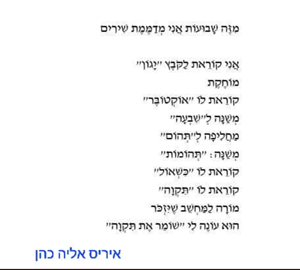
Tell the story of our enemies and the atrocities they have brought upon us in every generation, including this one – “שֶׁבְּכָל דּוֹר וָדוֹר עוֹמְדִים עָלֵינוּ לְכַלּוֹתֵנוּ,” – and how we have overcome and prevailed. We must publicly mourn and comfort, remember and memorialize. We tell their story, uphold their values, and promise that their sacrifice was not in vain. We must not leave anyone affected by the atrocities that happened this year standing alone. We must continue in our solidarity and never forget their sacrifice.
Share the story of the hostages, and how our hearts are torn apart. The citizens of the State of Israel and world Jewry find themselves in a profound crisis amidst the hostage situation and the uncertainty of war. We cannot afford to overlook this, nor can we neglect our history, the imperative to commemorate the Shoah, and the profound lessons it imparts. It is essential to lead a meaningful and relevant discussion on Yom HaShoah during the war, recognizing that without ongoing commitment to fortifying a robust and flourishing Jewish State of Israel and Jewish People, similar events remain a possibility.
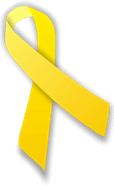
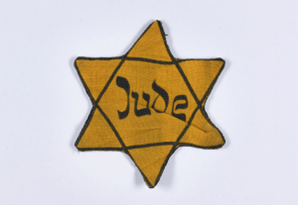
Tell the story of one hundred thousand evacuees who left their homes on the front lines. Those who have flourished on the borders, upholding Zionist leader Joseph Trumpeldor’s statement: “Wherever the Jewish plow plows its last furrow, that is where the border will run.” They are far from home and don’t know when they will return safely.
Tell the story of the amazing coming together of the Jewish people in unity, without inhibition, in times of crisis. Hundreds of thousands of soldiers and reservists mobilized within hours to respond to the threat and continue to fight on the front lines for the continuing existence of the Jewish people and the Jewish democratic state of Israel. The story of thousands of first responders who left everything and ran into the line of fire. The story of the hundreds of thousands of Israelis who rose to the occasion to help in every way possible and unite under the structure of the national effort to aid and support. Educators went out to educate, those who could cook prepared meals, hands helped in agriculture, and caregivers and therapists offered their support. Everyone pitched in to help, both in the military and civilian spheres.
Tell the story of world Jewry that rose to the occasion and took up the battle of supporting Israel on the international stage, socially, monetarily, and in every way possible. Tell the story of the Israelis who rose to the occasion and recognize that we are one people, the Jewish people, and when something occurs in Israel, it has major effects on members of our people outside of Israel. Many Israelis, during these times of crisis, follow and worry about fellow Jews across the globe. It is one story, our story, and we must tell it.
Immerse yourself in the Israeli cultural landscape during this period. Each year, as Israel commemorates its national holidays – Yom Ha’Shoa (Holocaust Remembrance Day), Yom Ha’Zikaron (Remembrance Day for fallen soldiers and victims of terror), and Yom Ha’atzmaut (Independence Day) – the country undergoes a noticeable transformation. This shift permeates every facet of public life, instantly recognizable to Israelis and evoking changes in both individual and collective sentiments.
You can hear it on the radio, where discussions and music selection reflect the solemnity or celebration of the occasion. It’s reflected in newspapers and television programs, in the headlines and stories shared. Out on the streets, billboards and slogans convey the prevailing mood, while cars proudly display flags and bumper stickers. Even social gatherings, schools, and the choice of destinations for group outings bear the imprint of this cultural shift. Indeed, this is manifested in numerous aspects of the culture that surrounds us during this significant period.
In the current period, there’s a unique soundtrack that differs from our usual tunes. Immersing yourself in Israeli culture allows for a deeper connection with Israelis. I personally take the time to engage with special TV programs and news segments, explore posted poetry, and discover new songs or reinterpretations of classics tailored to this time. From street signs and billboards to graffiti and special publications, these are just a few avenues worth exploring.
Following the tragic events of October 7, Israeli musicians were among the first to give voice to our collective grief. Their performances across the country offered a brief respite and served as intimate gatherings for people to come together. Many familiar songs have taken on new meanings during this time, accompanied by new lyrics and original compositions inspired by the events.
In times when words fail us, such as during war, we seek solace in those who can articulate our emotions. It’s often said that “when the cannons roar, the muses fall silent.” Yet, paradoxically, amidst the chaos of conflict, the voices of poets and artists resonate more profoundly from the depths of our hearts. We turn to contemporary poetry and other sources of inspiration, seeking words to express our individual and collective experiences. Creating a resource sheet comprising both historical and contemporary sources that echo the sentiments of songs and poems can provide comfort and guidance during challenging times.
Host a ceremony to commemorate one or all our national days. In Israel, these occasions are marked with solemn ceremonies that have held deep significance in the nation’s culture over the past 75 years. Each event and symbol resonates deeply with every Israeli. From the poignant moment of silence observed nationwide as the siren wails during memorial days, to the recitation of special memorial prayers, the honoring of exceptional military personnel and civilians, and the singing of Hatikvah, the national anthem, after each ceremony. These are just a few of the numerous events and symbols you can draw upon to resonate with and reflect our story and values in the hearts of Jewish people worldwide.
Offer support to those profoundly affected by the events of the October 7th attack and the ongoing state of war. Let them know that the Jewish people, even from afar, stand in solidarity with them. As a reservist, receiving personal letters in our care packages is incredibly heartening. Messages like, ‘To our heroes: My name is Benjamin, I live in New York, and I want to send you something small and sweet to brighten your day, and to let you know that we are praying for you,’ mean a great deal. Such gestures of support go a long way. Additionally, consider supporting the numerous businesses in Israel that have been impacted. Many of these are owned by reservists who are either currently serving on the battlefield or have returned and are facing challenges in getting their businesses back on track. Your support can make a significant difference.
Make a list of your inspirational Dreamers and Achievers, drawing motivation from their stories to inspire yourself and others. Craft a list outlining your aspirations and strategies to realize them for the betterment of the State of Israel and the Jewish People, identifying your own part and responsibilities. Share this list with family and friends, fostering a sense of collective purpose and commitment.
“For hundreds of years, people raise complete generations on the notion that dreams should be whispered quietly.
A falling star? Ask for a wish in your heart.
An eyelash fell out? Ask for a wish in your heart.
Blowing out candles on a birthday cake? Ask for a wish in your heart.
In your heart? Why in your heart? Who even hears that?
Why not tell our dreams to as many people as possible?
Why not “shout” them out on social media so that as many people as possible will hear and help us realize them?”[13]
In his book “The List: Shout Out Your Dreams,” Yuval Abramovitz suggests that sharing our dreams might bring them to the attention of someone who can assist us, thereby bringing us one step closer to fulfillment. Additionally, publicly declaring our dreams fosters commitment and brings us closer to achieving them. Share your aspirations for the Jewish people and the State of Israel—I’m eager to hear them!
Appreciate what we have. Give gratitude. Gratitude steers us away from two overly politicized emotions. On one hand, there’s absolute pride and glorification of the achievements of the State of Israel, and on the other hand, there’s criticism and guilt for the mistakes, faults, and setbacks we’ve experienced. Gratitude allows us to recognize that something significant has happened to the Jewish People without filling us with too much pride but rather with modesty. It’s about acknowledging the goodness others have done for us personally and as a collective Jewish People. Public gratitude is a declaration of awareness for what we have and the understanding that we need to fill the gaps in the world. Gratitude isn’t about what we lack but about being aware of what we do have as the Jewish People.
[1] https://www.youtube.com/watch?v=Pu-19veoyhs
[2] https://tentoda.org/about-us-2/
[3] Likutei Moharan, Part 2, 24:1. (Likutey Moharan Volumes 12-15, trans. By Moshe Mykoff. Sefaria.org.il)
[4] Mei HaShiloach, Volume 1, Leviticus, Emor. (Living waters, the Mei Hashiloach. Trans. And edited by Betsalel Philip Edwards, Jerusalem. sefaria.org.il)
[5] https://jewishrituals.org.il/ceremonies/an-invitation-to-choose-life/
[6] https://jewishrituals.org.il/
Many other comforting poems can be found on this page.
[7] See my blog ‘Continuting existence – the Jewish equationw’ https://zalman-israelguide.com/continuing-existence-the-jewish-equation/
[8]Micha Goodman, The Eighth Day: Israel After October 7th, 2024 [Hebrew], pp 11-13.
[9] Micha Goodman, The Eighth Day: Israel After October 7th, 2024 [Hebrew], pp 14-16.
[10] https://www.zikaronbasalon.com/en/home-2/
[11] Q4Israel, also known as The Fourth Quarter, is spearheading a transformation in Israel’s discourse, shifting from one dominated by politics and submission to one centered around hospitality, or “הכנסת אוחרים” (Hachnasat Orchim). This entails fostering a system of broad consensus through dialogue and discussion. They have initiated this shift through salons and parlor meetings, and despite their growth, they remain committed to maintaining this intimate setting for meaningful conversation. https://q4israel.org.il/en/#what-we-do
[12] https://tentoda.org/megila/ – See Ceremony of Reading the Declaration of Independence on Yom HaAtzmaut.
